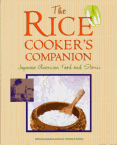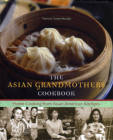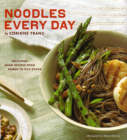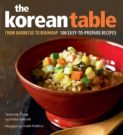Book Description from the Publisher's WebsiteFrom the elaborately symbolic foods of New Year's celebrations to the simple comfort food dishes of childhood, The Rice Cooker's Companion brings together recipes and recollections from Japanese Americans throughout the United States.From the Book's ForewardIt is certainly appropriate that the National Japanese American Historical Society has chosen to put together a cookbook as a historical document.I've often wondered if Japanese Americans are unusually food-obsessed. The answer, I think, is yes. Remarkably so, given the fact that we're not particularly vexed by weight problems. My theory is that we can afford to be food obsessed because we're choosy about the quality of the food we eat, and we also expend a lot of energy finding, fixing and fussing over the food. But food is not just physical nourishment. It has many levels of meaning for us as a people. For instance: Immigrant roots and making do: The issei, and sometimes older nisei, especially in areas where there were few Japanese, were unable to get many accustomed Japanese foodstuffs and at the same time confronted unfamiliar foods, such as canned tuna and hamburger. They therefore innovated, incorporating local "American" ingredients into Japanese dishes, leading to such concoctions as "hamburger sukiyaki" and "shoyu hotdogs" or combining Japanese and American elements in one meal, leading to combinations such as corned beef and cabbage with rice. I know that I was surprised to discover that other people ate potatoes with corned beef and cabbage. Additionally, over the years we nikkei have adapted to the regions in which we found ourselves. For example, in Hawaii, we incorporated Hawaiian, Chinese, Korean, and Portuguese elements to come up with the now-famous "plate lunch." In New England, we learned to make smoked turkey, and in Chicago, to chop up Vienna hot-dogs into our fried rice. Generational continuity and change: The preparing and eating of certain foods has been passed down from generation to generation. Some of these dishes were common to most Japanese, but many were specialties of the regions from which our forebears came, Okinawa, Hiroshima, Kumamoto or wherever. For sansei, our memories of grandparents is associated with particular dishes that we ate at jichan and bachan's house or that they prepared for us when they visited. Many of the recipes in this book are of that sort. On the other hand, changes in food preference also mark generational changes; some of the dishes that our grandparents liked no longer appeal to our taste buds (mochi) or seem too unhealthy (remember steamed pork fat?). In turn, new inventions with a Japanese touch, such as "somen salad" or "tofu quiche" that our grandparents would not recognize, have been added to our repertoire. Generosity and communal ties: Bringing dishes for family, church/temple functions, kenjinkai suppers, and picnics has been a way of sharing (and sometimes showing off!). Most of us remember the huge plates of sushi, teriyaki chicken, salad and other dishes brought by each family to contribute to these events. At the end, there would be enough to feed everyone again, so we each took plates of leftovers made up of bits from all of the platters. Comfort and celebration: We associate certain everyday foods with home and comfort. Mothers might serve us easy-to-digest food such as miso shiru or rice gruel when we were ailing. Conversely, our mothers, aunts, and grandmothers prepared elaborate foods for special occasions, especially New Year. In addition to chicken, sashimi, tempura, and sushi, there were dishes that appeared only once a year: baked fish tied to look as though it were leaping, ozoni, kuromame, and umani, and no Okinawan New Year was complete without pig's feet soup, andagii, and various pork dishes. For eating out "China-meshi" was the cuisine of choice. Weddings, funerals, birthdays, and anniversaries were observed with a banquet at a local Chinese restaurant. Old-time "China-meshi" favorites included chow mein, pressed duck, and sweet and sour spare ribs. Today, we're more likely to have Peking duck, General Gau's chicken, and steamed fish, washed down with ginger-ale or bubbly apple cider.
I have written a lot of this in the past tense, but the themes remain valid, even if the specific foods and practices have changed over the years. The cookbook editors have admirably captured the diversity and richness of Japanese American food traditions. Background on National Japanese American Historical SocietyThe National Japanese American Historical Society (NJAHS) is a non-profit organization dedicated to the preservation, promotion, and dissemination of materials relating to the history and culture of the Japanese American experience. NJAHS develops and presents exhibitions, videos, publications, interactive multimedia and public programs of the historical events, personalities, arts, and cultural crafts of the Japanese American community. |
|
|||
|
About | Contact | New | Specials | Browsing | Ordering | Conference | Links | Help Copyright © 2009 by AACP, Inc. Most recent revision December 4, 2009 |
||||




